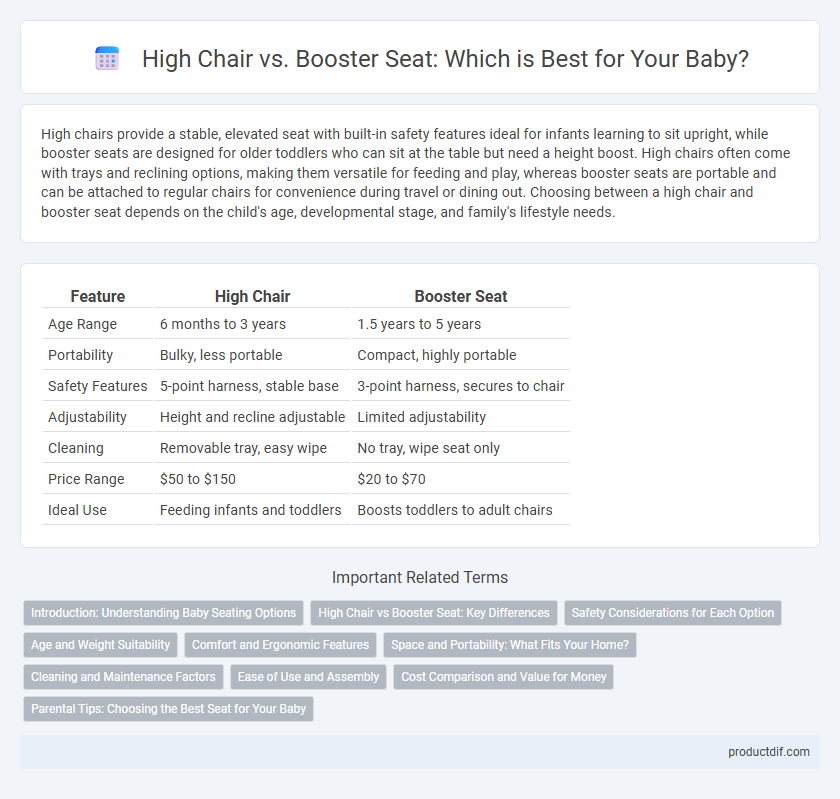High chairs provide a stable, elevated seat with built-in safety features ideal for infants learning to sit upright, while booster seats are designed for older toddlers who can sit at the table but need a height boost. High chairs often come with trays and reclining options, making them versatile for feeding and play, whereas booster seats are portable and can be attached to regular chairs for convenience during travel or dining out. Choosing between a high chair and booster seat depends on the child's age, developmental stage, and family's lifestyle needs.
Table of Comparison
| Feature | High Chair | Booster Seat |
|---|---|---|
| Age Range | 6 months to 3 years | 1.5 years to 5 years |
| Portability | Bulky, less portable | Compact, highly portable |
| Safety Features | 5-point harness, stable base | 3-point harness, secures to chair |
| Adjustability | Height and recline adjustable | Limited adjustability |
| Cleaning | Removable tray, easy wipe | No tray, wipe seat only |
| Price Range | $50 to $150 | $20 to $70 |
| Ideal Use | Feeding infants and toddlers | Boosts toddlers to adult chairs |
Introduction: Understanding Baby Seating Options
High chairs and booster seats provide distinct solutions for baby seating during mealtime, each designed to accommodate different stages of a child's growth and mobility. High chairs offer a standalone seating option with safety features like harnesses and trays, suitable for infants starting solids, while booster seats attach to regular dining chairs, ideal for toddlers gaining independence. Choosing between a high chair and a booster seat depends on factors such as the baby's age, weight, and the need for portability and ease of cleaning.
High Chair vs Booster Seat: Key Differences
High chairs provide a secure, elevated seating option with built-in safety features and adjustable trays, ideal for infants and toddlers during mealtime. Booster seats, designed for older children, elevate the child to table height and rely on existing dining chairs, offering portability and convenience. The key difference lies in stability and suitability: high chairs are standalone units with more support, while booster seats are compact, enhancing flexibility for traveling families.
Safety Considerations for Each Option
High chairs offer stable, enclosed seating with harness systems designed to prevent falls, making them safer for younger babies still developing balance and motor skills. Booster seats require secure attachment to an adult chair and often lack full support or safety harnesses, posing a higher risk if not properly used or supervised. Always ensure the product meets current safety standards and fits your child's size and developmental stage to minimize accident risks.
Age and Weight Suitability
High chairs are typically designed for infants starting around 6 months old up to toddlers weighing about 40 pounds, providing a stable and secure seating option with harnesses for younger babies. Booster seats are more suitable for older toddlers and preschoolers, generally from 18 months to 4 years old, supporting weights from 30 to 60 pounds while elevating the child to fit standard dining chairs. Selecting the appropriate seat depends heavily on the child's developmental stage, height, and weight to ensure safety and comfort during mealtime.
Comfort and Ergonomic Features
High chairs typically offer adjustable height and reclining positions, providing superior ergonomic support and comfort tailored to growing babies. Booster seats prioritize portability and simplicity but may lack customizable features like padded cushions or footrests found in high chairs. Choosing between the two depends on the baby's age and the importance of ergonomic design to ensure proper posture during mealtime.
Space and Portability: What Fits Your Home?
High chairs typically provide a stable, full-sized seating option with trays and adjustable features but occupy more floor space and are less portable. Booster seats are compact, lightweight, and easy to move, making them ideal for smaller homes or travel. Consider your living area dimensions and storage options to choose between the bulkier high chair or the space-saving booster seat for efficient mealtime arrangements.
Cleaning and Maintenance Factors
High chairs typically feature removable trays and washable cushions designed for easy cleaning, while booster seats often have simpler designs with fewer parts to disassemble. High chair surfaces made from plastic or metal resist stains and can be wiped clean quickly, whereas fabric booster seat covers may require machine washing, impacting maintenance time. Choosing between a high chair and a booster seat largely depends on how much effort parents prefer to spend on daily cleaning and long-term upkeep.
Ease of Use and Assembly
High chairs generally offer straightforward assembly with adjustable features designed for quick setup, providing parents convenience and stability during mealtime. Booster seats are typically lightweight and portable, often requiring minimal assembly or simply securing to an existing dining chair, making them ideal for on-the-go use. Both options emphasize user-friendly design, but high chairs tend to be more durable and versatile for extended use.
Cost Comparison and Value for Money
High chairs typically range from $50 to $250, offering adjustable features and durability that justify the higher price for long-term use. Booster seats are generally more affordable, priced between $20 and $70, making them a cost-effective option for short-term or occasional use. Investing in a high chair often provides better value for money due to enhanced comfort, safety features, and extended usability.
Parental Tips: Choosing the Best Seat for Your Baby
Selecting the right seat for your baby involves assessing safety features, comfort, and age appropriateness. High chairs provide stability and adjustable height with harness systems suitable for younger infants, while booster seats offer portability and convenience for older toddlers who can sit independently. Prioritize ease of cleaning and compatibility with your dining setup to ensure a practical and secure feeding experience.
High Chair vs Booster Seat Infographic

 productdif.com
productdif.com